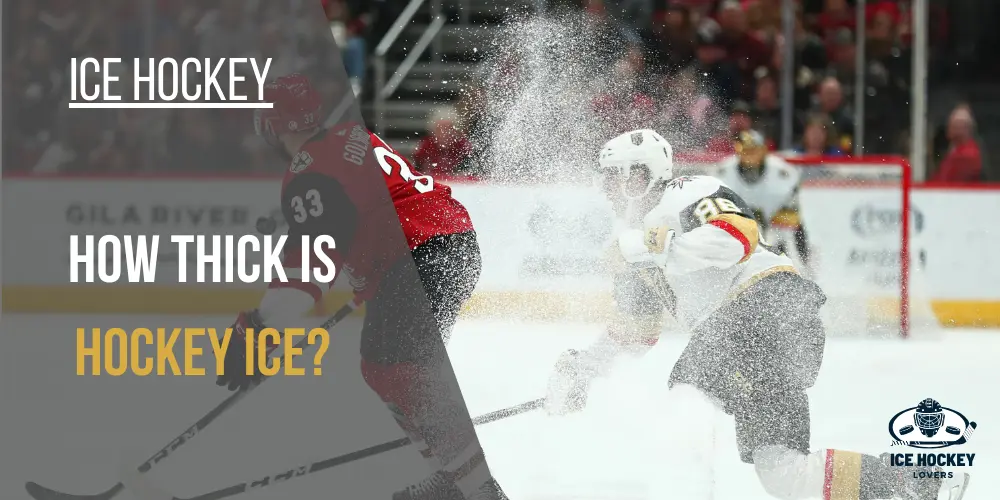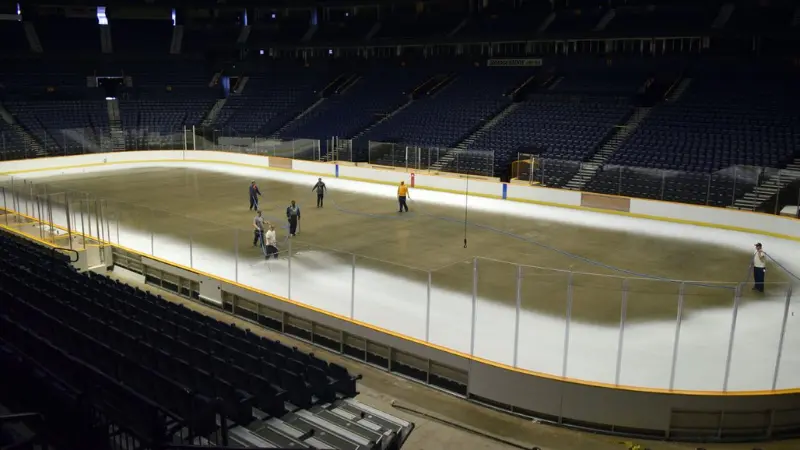NHL Ice Thickness: How Thick is Hockey Ice?

In many parts of the world, ice hockey is a trendy game. In addition, it is known for its quick swings, fast skating, and rapid changes in pace. Ice hockey is different from other sports because it is played on ice instead of on grass or ground.
People watching this game are more consulted regarding the NHL standard of rink size and the thickness of ice used in these rinks.
How thick is the ice in the hockey rink? The ice thickness on the hockey rink is ¾ of an inch or 0.75″ thick. It is equivalent to 1.905 centimeters or 19.05 millimeters. This ice is thinner than any other skating surface. Lighter surfaces are helpful for the players to stake more easily, have better control, and let the water freeze quickly.
The temperature of ice is kept at 16°F so that the ice remains chilled and prevents it from melting. Ice hockey thickness required 10,000 gallons of water to make a perfectly smooth surface.
Keep reading this article to know more about ice thickness on the hockey rink.
Table of Contents
The thickness of the Ice on the Hockey Rink
As the size of the rinks is specified, the ice hockey thickness is also restricted by the NHL. The ice at the hockey rink is ¾ of an inch or 0.75″ thick, equal to 19.05 millimeters.

So we can see that the hockey surface are too thin, while players enjoy playing on the thicker surfaces. Thin ice helps in freezing the water quickly and makes the surface harder, making the game easy. As hockey is a fast-paced game, thick ice makes the surface slow and soft; therefore, the thickness of the NHL is kept thin.
How is the Ice in a hockey rink made?
After knowing the thickness of ice on the hockey rinks, you should also know that making ice is complicated and takes time. Just the pouring and freezing do not make this ice of water.
Water is mixed with chemicals to have a smooth texture of the layers which helps players to move quickly. As the hockey ice rinks are made by layering the ice. The first layer is made by simplifying spraying the water on the slab.
When the last layer is frozen, a tiny fraction of an inch is sprayed on the ice. The top layer of ice is painted white so that fans and players know where to pucks; advertisements are also shown on this layer.
How marking on the ice is made?
Marking on the ice is helpful for both players and fans in understanding the game being played. These Marks include blue lines, center ice, goal line, face-off circles, and ceases.

These marks are made on the thin layer of the ice that is thicker up to the need. Another coating of ice is done to secure the marks.
How is ice in the hockey rink kept frozen?
Two methods are used to keep the ice on the hockey rinks frozen; one is refrigeration, and the other is brine.
In the refrigerator, the cold water is passed through the pipes under the rink’s surface, and their temperature is kept at 32°F, which helps in freezing the water placed on the layers. Brine creates a salt layer at the top of the ice.
With the help of insulation, all the heat is removed from the outside or inside sources.
Factors on which the thickness of ice hockey depends
Factors on which the thickness of the ice of rinks depends are:
- The water is used while making the layers.
- The Refrigerating system used.
- Quantity of water being used.
- The temperature of the water
- The temperature of the air.
How is the thickness of Ice measured?
The thickness of hockey ice is measured in millimeters, and it varies from team to team as NHL uses a depth of 25 mm(1 inch), groups in North America have ice rinks of a thickness of 90 mm, and college teams have a thickness of 50mm(2 inches). They all come in the range of 76mm to 102 mm. The thickness of ice in indoor ice is 23.28 mm, and outdoor rinks have a thickness of 98mm.
Players should know the thickness of the ice of the rink in which they are going to players as these will help them to understand how much energy is required to skate.
Frequently Asked Questions
How thick is Olympic ice?
In Olympics, the thicknesses of ice on the rink vary. Short-track speed skating ice is about 1 to 1.25 inches, while figure skating is about 1.5 to 2 inches thick.
How many layers of ice are on a hockey rink?
The first few visible layers on the ice hockey rink are painted with hockey markings and advertisements. These layers are then covered with about 8 to 10 more layers.
How much water is in an ice rink?
About 12,000 to 15,000 gallons of water are required to form an ice rink.
Why does the ice rink not melt?
A refrigeration system is used to keep the ice frozen. The refrigerant absorbs the heat, which is absorbed by the secondary liquid.
Conclusion
In conclusion, the thickness of ice on the hockey rink is thinner than any other rink, but as hockey is a fast-paced game, this thickness is the best as it allows players to move quicker, and the ice freezes well fastest. It is appropriate for the players to know about the ice rinks as it will affect their game.

Who is Austin Taylor?
Meet Austin Taylor, your go-to source for everything ice hockey! With a passion for the sport that’s as deep as the ice itself, Austin Taylor brings you concise, expert insights and nitty-gritty details on all things hockey. From gear reviews to strategy breakdowns, Austin Taylor is your trusted guide to navigating the exhilarating world of ice hockey. Get ready to lace up your skates and dive into the game with Austin Taylor as your ultimate companion.




